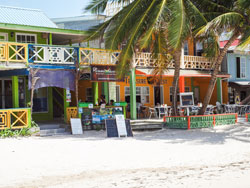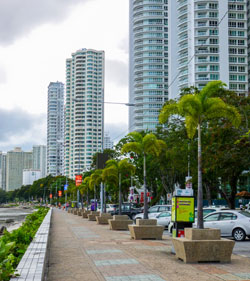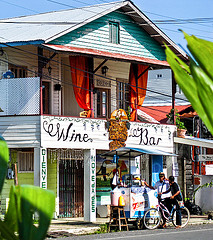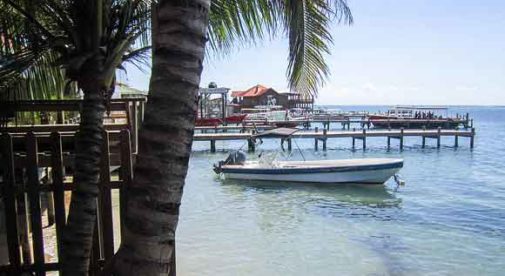“I love the greens and blues,” says Washington native Deb Crofutt of her new life on a tropical island. “I love the smiles on the faces of everyone I make eye contact with. I like being away from the hustle and bustle of home and the pressure to own ‘things.’ I spent so many years working in the corporate world just to have stuff. This is a simpler, better life.”
Imagine the feel of the warm sun on your shoulders as you walk along a pristine white sand beach stretching to the horizon, fringed by palm fronds and the sumptuous blue ocean. You’re on your way to your favorite bar to enjoy a cocktail with expat friends as the sun goes down. All part of your new laidback lifestyle free from stress. For many people, particularly snowbirds seeking to escape the biting North American winter, this is their ideal retirement. An affordable island with a carefree lifestyle, modern amenities and sunshine all year round.
In this article, we outline the best five tropical island paradises for retirees. These places meet all the criteria needed to make them perfect retirement havens. As well as looking the part, all five of these islands—spread throughout the world—are becoming easier to get to as more and more flights open up to and from North America. Many tropical getaways have been consumed by commercialism, leaving them beyond every reasonable budget. But the islands on our list remain affordable, as attested by our expat experts on the ground. On some, it’s possible to live for as little as $1,500 a month including rent.
At the same time, all of these islands boast the infrastructure you need to enjoy a happy retirement. Health care facilities are either on the islands themselves or a short distance away. On one you will find fully modern hospitals; the others are serviced by basic clinics, but fully-equipped hospitals are only an hour away. Also, while some tropical islands are the exclusive haunts of party-seekers and backpackers with a thirst for thrills, the islands that make our cut can cater to retirees in search of a more relaxed experience…although that’s not to say that there’s not plenty of excitement and adventure for those who want it.
In the end, it’s up to you to decide which one best fits your fantasy of a complete tropical getaway. You can have a beach hut right by the waves or a high-end home with its own swimming pool. Would you rather spend your days relaxing by the sea or prefer to indulge in a more active retirement, immersing yourself in nature as you explore dense rainforest and rugged mountains? Do you want a secluded retreat without big crowds or do you need a lot of people to make your tropical island homely? All of this comes down to personal taste, and no matter what your tastes are, you’re sure to find somewhere that fits your needs among the five islands we’ve selected.
The tropical retirement of your dreams could be easier than you thought. Read on to find out more.
1. Roatán, Honduras: Affordable, Laidback Island Haven
By Amanda Walkins
Located off the East Coast of Honduras, Roatán is the largest and most developed of the country’s Bay Islands. With its own international airport, a well-established expat community, and modern amenities mixed with rustic charm, Roatán offers retirees an incredible opportunity for a new life in paradise.
Each morning in Roatán I’m greeted with vibrant sunshine and the enchanting sounds of a jungle awakening. I often take advantage of the stunning sunrise to walk along the beach to start the day. A late-morning swim or snorkel in the warm, clear waters lets me see some of the most incredible coral reefs in the entire world. Frequent meet-ups are arranged by different expat groups throughout the island, from beach days to afternoon meetings on the dock with tropical cocktails in hand.
Roatán is filled with small communities where expats and locals mix and create endearingly intimate neighborhoods. Often bumping into each other at the grocery store or on the street, residents find it’s impossible to run errands quickly. But there is an unfailing feeling of camaraderie where everyone understands that time is a fluid concept and the moments of each day are more important than checking items off of a to-do list.
Stretching about 35 miles long and only five miles wide at its widest point, Roatán offers breathtaking hillside views and affordable beachfront property. With growing interest in Roatán in recent years, now is the time to take advantage of the great deals still available in this little paradise. The island still offers pristine land, untouched and undeveloped, for investors to custom-build a new home. There are also plenty of move-in ready options, particularly the beautiful cottage-style houses in the popular expat neighborhood of West Bay called Turtle Crossing. Alternatively, the state-of-the-art condos of stunning Pristine Bay overlook not only the amazing blue ocean, but also the vibrant greens of Roatán’s Black Pearl golf course, designed by the legendary Pete Dye.
Rentals are plentiful as Roatán enjoys a large market of repeat visitors and short-term residents. Apartments and homes rent for one month, three months, six months, or more. Potential expats often rent short-term in various neighborhoods before committing to a long-term rental or purchase. The cost of renting and living on the island remains highly affordable (see sidebar).
Grocery stores are filled with North American staples and restaurants offer everything from Southeast Asian cuisine to pizza and hamburgers. Caribbean flavors are infused with Latino spice and international influences to create a multi-cultural dining scene.
Expats also enjoy the convenience of basic, low-cost healthcare on Roatán with several medical facilities on the island and pharmacies offering medications over-the-counter. Those who prefer to still use their own doctors back home simply keep their insurance active, and many expats maintain a basic level of healthcare back home solely for emergencies. Others, like Deb and Bill Crofutt from Everson, Washington, don’t bother with health insurance payments at all. “If we need to see a doctor we go to one of the clinics here,” Deb says. “We can get our prescriptions filled for three months for less than the co-pay in the U.S. with insurance. If we should need medical, we’ll go to the mainland or to Panama.”
Many expats actively support their new communities as well, volunteering with a variety of organizations providing local services. Tricia Rolston Power, originally of Baton Rouge, Louisiana, spends much of her free time working to better the community. She is a member of the Board of Directors of the Roatán Humane Society and also a sponsor for a local family, helping to provide medical care, education, and employment opportunities. “I try to get involved in my community every time I see a need or I am called upon,” she says. “And I feel very lucky that I have been chosen to do so.”
The longer I live in Roatán, the more I feel the kind of freedom and pure joy reminiscent of my childhood. And I all too frequently find myself commenting on how lucky I feel to be living in such a special place.
2. Ambergris Caye, Belize: Paradise at Your Doorstep
By Ann Kuffner
If you’re after a laidback, English-speaking Caribbean retirement at an affordable cost and with easy access to the States, you can’t do much better than Ambergris Caye, Belize’s largest island. Ambergris has racked up a series of impressive “best island” awards over the last few years; the island received Trip Advisor’s Traveler’s Choice Award for Best Island for 2013 and 2014. But Ambergris Caye is much more than a tourist destination. It’s a perfect retirement haven.
Every day I can enjoy the gorgeous Caribbean Sea and the sight of waves crashing on the offshore Mesoamerican Barrier reef. The Caribbean’s aquamarine hues never fail to dazzle me… With the sea to the east, and the lagoon to the west, breath-taking water views surround us here on Ambergris. I just love how the weather is so balmy, year round, that we can dine at an open air beach café, day or night, without the need for a sweater.
The island receives 60-70 inches of rain/year. The temperature seldom rises above the mid-80s F during the day, or below the 70s F at night. Caribbean trade winds provide a cooling effect, making it feel much cooler than the thermometer indicates. The temperature of the Caribbean Sea gets up to 84 F and swimming is comfortable all year.
It’s easy to fly to Belize, and to Ambergris, from North America; American, United, USAir, Delta and Avianca fly direct from cities such as Houston, Miami, Dallas, Charlotte, and Atlanta. In 2014 a few new direct flights were added, from Los Angeles and Chicago, to address rising tourism demand. In October of this year Southwest will initiate direct flights to Belize.
It’s possible to live on Ambergris for under $2,000 a month, although this is easier if you own your own home. How much you pay in rent is usually determined by how close you want to live to the beach, with beachfront properties usually commanding a higher price. Away from the beach, lots are available for less than $750 a month. If you plan to stay part of the year, you can rent out your property for the rest to cover the cost.

Belize is a small country, with only 330,000 people. Ambergris Caye itself has less than 20,000 residents. Given the size, the health care options are not broad. But there are a decent number of competent, committed doctors on the island, so basic health care service is good. Ambergris Caye now has a 24-hour clinic, the Los Pinos Clinic, located across from the airstrip. The best hospitals are located in Belize, which is a 20 minute flight away. And Ambergris Caye’s airstrip was modified a year ago to allow for night flights.
There’s an active expat community on the island, and many expats live here full-time. They spend their time enjoying the stunning natural environment and outdoor activities: volunteering at their local church or favorite nonprofit, running a business part- or full-time, attending a gym or yoga studio, and participating in the myriad social activities and local events. It’s surprising how many diverse people come and go on this lively little island. You’ll often find that you need to juggle your social calendar as you meet new, interesting friends, some of whom live on the island, and others who pass through on a regular basis. For me, retirement on Ambergris never gets boring…
3. Penang, Malaysia: Brilliant, Affordable Health Care
By Keith Hockton
One of the oldest outposts of the former British Empire, Penang delivers 110 square miles of tropical treasures. A lush, mountainous island oozing history and heritage, Victorians christened it “the Pearl of the Orient.” It lies anchored on the Spice Route, just off Malaysia’s west coast, a mere two-hour drive from the borders of southern Thailand.
Around 41% of the island’s 600,000 inhabitants are of Chinese descent. From the Snake Temple to mooncakes and elaborately decorated clan houses, their culture and traditions survive intact. As do those of Penang’s Malay and Indian communities. Many foreign retirees also opt for a new life on Penang, only a 50-minute flight from Kuala Lumpur. It’s also accessible by an eight-mile long road bridge and a ferry from the mainland that runs 24 hours a day. A second bridge was completed mid-2014 and a tunnel is planned for 2034.
George Town is Penang’s capital city. A UNESCO World Heritage Site since 2008, it’s one of Asia’s most likable cities. Blending old and new, modern high-rises encircle streets packed with mansions, shop-houses, and Chinese clan houses.
There’s plenty in Penang for colonial history buffs and foodies too. Penang also delivers first-rate hospitals that offer unbelievable heath care at super reasonable prices. Just one of the reasons the island has two planeloads of medical tourists arriving every day, and when it only costs $20 to see a specialist you can understand why.
Western-style shopping is the norm, and good beaches are on your doorstep. A 60-cent bus ride takes you past upmarket Gurney Drive to Batu Ferringhi’s golden sands. Gurney Drive’s promenade is a favorite spot to catch well-to-do locals promenading at night and at weekends, and there are a few of the old grand mansions on view.
Penang is also terrific for an outdoor lifestyle. I can be at the beach within minutes of leaving my apartment or in the jungles hiking in the same amount of time and never see another soul for hours on end. When I want, I can cycle around the whole island in a day.

People from Penang are called Penangites and food is always on their mind. If they are eating breakfast they are thinking about lunch. If they are eating lunch they are thinking of an afternoon snack. You get the picture. There’s a dazzling array of stalls and restaurants selling delights such as charcoal-baked crabs, salt-baked shrimp, and Penang’s signature fried flat noodle dish, Char Koay Teow. It’s cooked using sweet dark soy sauce, bean sprouts, garlic, onions, Chinese sausages, prawns, chili, and squid. People drive from miles around just to sample it.
Penang reminds me of Malibu, California. Not because of the prices—in fact, far from it. But the road fronting this area is right on the ocean, just like Malibu. It’s a lovely, leafy, coastal area and one of the oldest neighborhoods on the island. There is a large retired and working expat population on the island, and there are a plethora of clubs, art galleries, museums and cafés to keep you occupied for a very long time. Throw into that mix dinner parties, golf and tennis days and beach BBQ’s and you get a good idea of how active the expat population is.
4. Koh Samui, Thailand: Hidden Jewel of the Orient
By Jason Gaspero
Think of a tropical island that offers just about everything the discerning retiree could want.
It’s warm and balmy 12 months a year. English is widely understood everywhere. There’s a thriving expat community. The hospitals and health care options are of high-quality. And it’s still a big-time bargain when compared to other well-developed tropical islands worldwide.
It’s Koh Samui—an 88-square-mile gem in the Gulf of Thailand. Situated about 400 miles south of Bangkok, Koh Samui has become one of the most coveted overseas expat and retirement destinations in the entire world. And for good reason.
Samui boasts world-class beaches tucked away in secluded bays, expansive inland jungles teeming with exotic birds, butterflies, and monkeys, magnificent cascading waterfalls and inland natural pools, and an almost countless choice of great spots to sit down, relax and watch the spectacular sunsets over the Gulf of Thailand.
The island offers much exotic tropical beauty and exciting outdoor activities like deep-sea fishing, scuba diving, horseback riding, archery, golf, tennis, jungle trekking and so much more.
It’s also got just about every modern amenity you could ever think of within minutes of your front door, from air-conditioned shopping malls stocked with every modern good you’ll find back home to high-speed broadband Internet and fast, reliable island-wide 3G coverage. I have a choice of 18-hole championship golf-courses with jaw-dropping panoramic views, movie theatres, fully-stocked grocery stores, modern gyms, car and motorbike dealerships and much more.
One of the many things about life in Koh Samui I adore is there are people from all over the world. On any given night out, I imagine there are at least three-dozen nationalities under one roof. Everyone seems to love the warm weather, cheaper prices, and of course, the legendary friendliness of the Thai people. It is this that made me feel right at home here in this Oriental haven.
A round-trip flight from Los Angeles (LAX) to Samui will run anywhere from $1,100 to $1,500 and up depending on what time of the year you book your flight. High season in Samui (which is also when the weather is the most sunny and pleasant) runs from late-December to mid-March.
Samui features a tropical monsoon climate, so it’s sunny, warm and humid most of the year. However, it gets quite cloudy and wet in October and November during the rainy season, so make sure to pack your waterproof jacket if you plan to stay that time of year. Cheap ponchos are also available for sale in many stores and supermarkets.

Property deals in Samui run the entire gamut. For example, if you’re really budget conscious and don’t mind living frugally, you could rent a property like a furnished apartment with Wi-Fi, satellite TV, hot water, and a king size bed in bustling Chaweng for just 5,500 baht ($169). If you’ve got a slightly higher budget, you could rent a two-bedroom, one-bathroom apartment with a living area, kitchen and just five minutes from expat hotspot Lamai for 20,000 baht ($614).
If you’d like to buy a home in Samui, you can find deals like a brand-new fully-furnished one-bedroom apartment with one ceramic-tiled bathroom, a living room, a kitchen, a terrace, beach access, a gym, high-speed internet, concierge service and dozens more highly-valuable owner amenities for just 2,999,999 baht ($92,000). And if you need a little more room, you could buy a fully-furnished two-bedroom home in a quiet area of Samui with a private pool, your own parking area, over 300 square meters of land and air conditioning for just 6,350,000 baht ($195,204).
English is widely spoken, so I don’t have to worry about being misunderstood. It’s not expensive, either—especially when compared to Western prices. An appointment with a specialist costs just 200 baht ($6.14).
Popular health insurance options include Bupa International and Pacific Prime. And by the way, many prescriptions are available “over the counter” at much, much lower prices than you’ll find back home. And pharmacies seem to be everywhere in Samui!
It’s hard to say how many expats live in Samui at the moment. Some estimate the expat population at a little under 50,000… so you’ll definitely find more than a few like-minded expats on the island, if you know where to look. Popular hangouts on the island include Chaweng, Lamai, Bophut and Mae Nam.
5. Bocos del Toro, Panama: Relaxing Island Retreat
By Jessica Ramesch
 Soft breezes, reggae music, the Caribbean lapping against the shore… Bocas del Toro is a soothing kind of place. Sitting on an over-water deck, sipping a rum and cola, I tend to forget every worry. The Caribbean here is warm and clear. Depending on where you sit, it looks a pale jade, electric blue, or a translucent turquoise. Views are quintessential Caribbean…pale white sand and lush green palms. It’s the kind of scenery that takes your blood pressure down.
Soft breezes, reggae music, the Caribbean lapping against the shore… Bocas del Toro is a soothing kind of place. Sitting on an over-water deck, sipping a rum and cola, I tend to forget every worry. The Caribbean here is warm and clear. Depending on where you sit, it looks a pale jade, electric blue, or a translucent turquoise. Views are quintessential Caribbean…pale white sand and lush green palms. It’s the kind of scenery that takes your blood pressure down.
Bocas del Toro is one of Panama’s 10 provinces. But the expats who live here choose to make their homes on the archipelago rather than the mainland. Isla Colon is the main island and population center, often referred to as Bocas Town.
Restaurants, tour operators, hotels, and bars sit next to the little markets referred to as “mini-supers.” Tucked in between are old-fashioned shops, deeper than they are wide, with everything from baskets to flip-flops piled up to the ceilings.
There are places where you can buy a local beer for about 50 cents or have a gourmet meal for $30. For a little variety, surrounding islands offer a watery world to explore. Some are tiny and uninhabited… you can have stretches of white sand all to yourself. Others may boast a few little B&Bs or restaurants, or indigenous settlements.
Satellite television, cell phone service, and high-speed internet are all available and have been for years. There’s a small public hospital on the island that can deal with basic illnesses and injuries. In Panama City, a one-hour flight away, larger facilities offer all the modern equipment and complex procedures one would expect of your average U.S. hospital.
I don’t recommend buying property in Bocas as it’s one of very few areas in Panama where securing title to your property can be an issue. Property for rent, however, is readily available and very inexpensive compared to more popular Caribbean destinations. Smaller apartments can start as low as $500 a month, and three-bedroom, two-bath homes range from $600 to $900 a month. Expect to pay more closer to the main center or for ocean views.
The islands of Bocas del Toro are among the most beautiful in the world, but Bocas is wet year round. Most days start out sunny and showers come in the afternoons.
There are no hurricanes here, however, and temperatures are never extreme…they tend to average about 88 F.
There are no direct international flights to Bocas del Toro. To get here, fly to Panama City’s Tocumen International Airport and then switch to the domestic airport for a one-hour flight. You can also go by car or bus; it takes about seven hours to get to the water taxi at Almirante. From there it’s a half-hour to Isla Colon.
Life in Bocas is all about relaxing. The expats that live here are of all ages and tend to be mellow, easygoing types. The dress code is “beach casual” and outings consist of a couple beers and maybe some live music, courtesy of musically-minded residents or transient talent.
There are plenty of ways to get involved in island life. Some of the restaurants and hotels here are expat owned, and you’ll hear residents talk about teaching local students or volunteering for important causes.
The influx of expats and small but steady stream of tourists has made Bocas a much more homely place than when I first visited in the late 1990s, and have helped make it a place well worth considering for your tropical island retirement.

Get Your Free Report on the World’s Best Places to Retire:
Learn more about the best places in the world to retire in our daily postcard e-letter.
Simply enter your email address below to sign up for our free daily postcards and we’ll also send you a FREE report on The World’s Top 10 Retirement Havens, plus access to over 10 more free reports. Our gift to you, on our favorite destinations.
Related Articles
5 Affordable Caribbean Islands to Live On… and 2 to Avoid
Three Great English Speaking Islands

